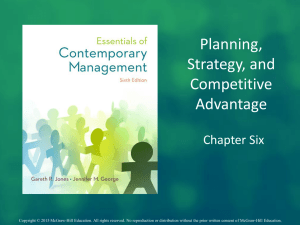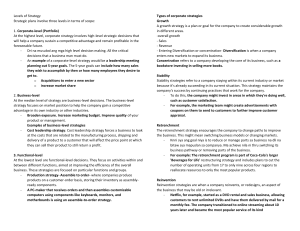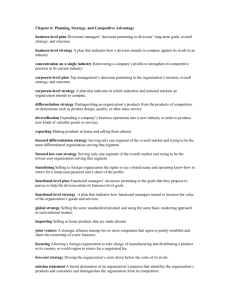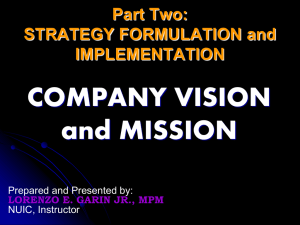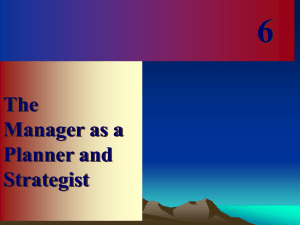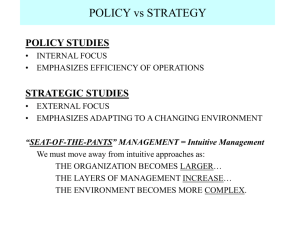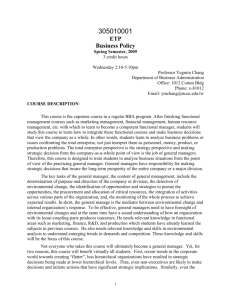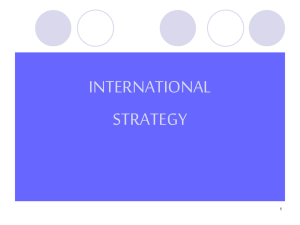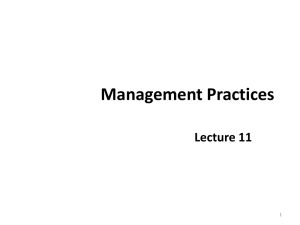4. Essentials of Planning. - NMHU International Business Consulting
advertisement
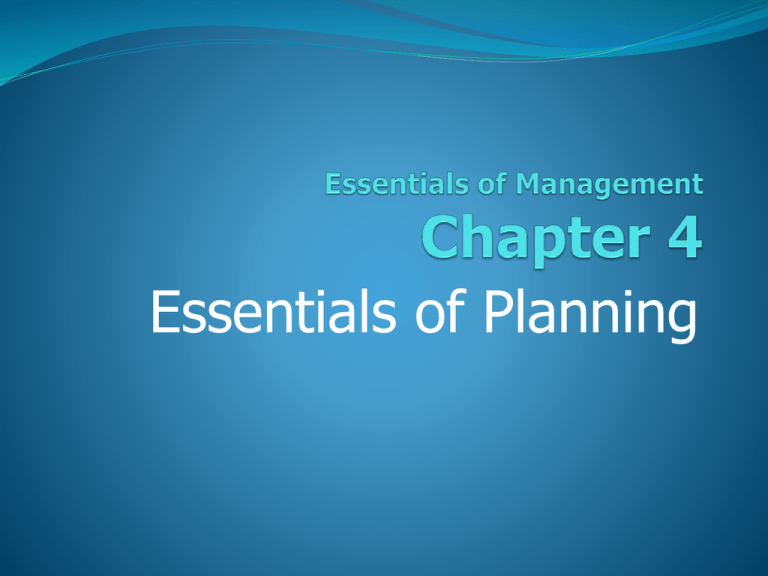
Essentials of Planning Three Types of Planning Strategic planning establishes master plans that fit the destiny of the firm. Tactical planning translates strategic plans into specific goals for organizational units. Operational planning identifies the specific procedures and actions required at lower levels in the organization. Both tactical planning and organizational planning support the strategic plans. A General Framework for Planning Define the present situation (includes examining internal capabilities and external threats and opportunities). Establish goals and objectives (a starting point for planning). Analyze the environment to forecast aids and barriers to goals and objectives (helps predict factors that will foster or hinder attaining goals). A General Framework for Planning, continued Develop action plans for reaching goals and objectives (without action plans, goals may not be attained). Develop budgets (most action plans require money, so realistic budgets have to be developed). Implement the plans (plans are often developed then forgotten). A General Framework for Planning, concluded Control the plans (evaluate progress and make any necessary adjustments for lack of progress). Make contingency plans (develop an alternative in case the original plan cannot be implemented successfully or at all; an exit strategy might be part of the contingency plan). The Nature of Business Strategy 1. 2. Porter says that true business strategy has four components Strategy involves more than operational effectiveness (being efficient alone is not enough for sustained profitability). Strategy rests on unique activities (deliberately choose a different set of activities to deliver a unique value). The Nature of Business Strategy, continued 3. 4. A sustainable strategic position requires trade-offs (necessary when activities are incompatible such as offering online wine buyers wine tasting). Fit drives both competitive advantage and sustainability (efficiently combine activities for making product or service). Strategy also involves “thinking big.” The Development of Business Strategy Business strategy develops from planning, leading to vision, mission, and policy. A vision is idealized picture of organization’s future. A mission identifies firm’s purpose, and where it fits into the world. Strategy can also come from inspired thinking. Corporate values can influence strategy. The Development of Business Strategy, continued 1. 2. Three major approaches to developing strategy are presented next. Gathering multiple inputs to formulate strategy (a wide range of parties at interest are consulted). Analyzing the realities of the business situation (strategist must make valid assumptions about the environment). The Development of Business Strategy, concluded. 3. a. b. Performing a SWOT analysis (considers the strengths, weaknesses, opportunities, and threats in situation). Preparing for analysis (be clear about what you are doing and why). Conducting the analysis (good points, internal strengths, risks, internal weaknesses, opportunities, threats). Sample Suggestions for Sizing up the Environment (Exhibit 4-5) What markets do we serve? Who are our customers? Who are our competitors? What kind of relationship do we have with our customer? Who are our potential competitors? What is the industry’s value chain? Where is value added? Sample Suggestions for Sizing up the Environment, continued What technologies are important in our industry? How does our firm compete? What are the key factors of production? What are the key success factors (in our industry)? What trends and factors in the external environment are important in our industry? How are they likely to change? Levels of Business Strategy Corporate-level strategy concerned with total direction of enterprise and selection of businesses. Business-level strategy focuses on how to compete in each of the businesses. Functional-level strategy specifies actions to implement above two strategies. Functional managers should support corporate- and business-level strategies. Five Competitive Forces 1. 2. 3. 4. 5. Power of customers to affect pricing and profits Power of suppliers to influence price Threat of similar or substitute products Level of competition that impacts investment in marketing and research Threat of new market entrants to intensify competition, impact profits Types of Business Strategies Eight illustrative types of business strategy are presented here under the level they best fit. Corporate-level strategies a. Strategic alliances b. Diversification c. Sticking to core competencies (what the firm does best) Types of Business Strategies, continued a. b. c. Business-level strategies Product differentiation (be different from the competition) Focus (concentration on a specific regional or buyer market) Cost leadership (low price without total sacrifice of quality) Types of Business Strategies, concluded a. b. Functional-level strategies Finding and retaining the best people High speed (in product development, sales response, and customer service) Strategy must be selected and executed carefully. Jumping from strategy to another is bad, yet be flexible in response to changes. Operating Plans, Policies, Procedures, and Rules Plans, policies, procedures and rules convert strategic plans into action. Operating plans enable strategic plans to alter destiny of the firm. Policies are general guidelines to follow for making decisions and taking action. Policies support strategic plans in every area of the organization. Operating Plans, Policies, Procedures, and Rules, continued Procedures establish a customary method of handling future activities. State specific manner for accomplishing an activity. Rules are specific courses of action or conduct that must be followed. Rules should fit the strategic plan. Policies, procedures, and rules protect company assets, guide worker actions. Management by Objectives: A System of Planning and Review 1. 2. 3. 4. 5. 6. Establish organizational goals. Establish unit objectives. Review subordinates’ proposals. Negotiate or agree (with subordinate). Create action plans to achieve objectives. Review performance.
